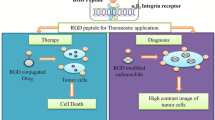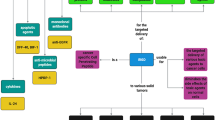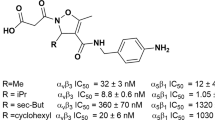Abstract
Retro-inverso peptide represented the isomer of a parent peptide in which the direction of the sequence was reversed and the chirality of each amino acid residue was inverted. Generally, retro-inverso peptides possessed equal or even higher activities compared to the original peptide. RGD was a commonly used ligand for tumor and vascular targeting due to its affinity to integrin αvβ3 receptors. The biological activity study of the isomers of RGD would indeed provide useful suggestions for the design of tumor targeting peptides. Therefore, the tumor targeting activities of octa-arginine which was modified with different retro-inverso sequences of RGD peptide were investigated in this study. Three different tandem peptides (R8-GDGR, R8-GdGr and R8-GdGR) were designed on the basis of R8-GRGD. The tumor targeting activities of these tandem peptides were evaluated both in vitro and in vivo. Finally, R8-GdGR displayed selective binding affinity to integrin αvβ3 at the cellular level, and exhibited efficient tumor homing and penetrating capabilities in vivo. Meanwhile, R8-GdGR also showed stronger neovessel targeting ability compared to the others. In conclusion, all the results demonstrated that dGR possessed similar biological activity to RGD and was a potential ligand for further designing of tumor targeting peptides.





Similar content being viewed by others
References
Abraham T, Prenner EJ, Lewis RN, Mant CT, Keller S, Hodges RS, McElhaney RN (2014) Structure–activity relationships of the antimicrobial peptide gramicidin S and its analogs: aqueous solubility, self-association, conformation, antimicrobial activity and interaction with model lipid membranes. Biochim Biophys Acta 1838(5):1420–1429
Alberici L, Roth L, Sugahara KN, Agemy L, Kotamraju VR, Teesalu T, Bordignon C, Traversari C, Rizzardi G-P, Ruoslahti E (2013) De novo design of a tumor-penetrating peptide. Cancer Res 73(2):804–812
Barczyk M, Carracedo S, Gullberg D (2010) Integrins. Cell Tissue Res 339(1):269–280
Bernstein H-G, Dobrowolny H, Trübner K, Steiner J, Bogerts B, Hoffmann W (2015) Differential regional and cellular distribution of TFF3 peptide in the human brain. Amino Acids 47(5):1053–1063
Choi KY, Chung H, Min KH, Yoon HY, Kim K, Park JH, Kwon IC, Jeong SY (2010) Self-assembled hyaluronic acid nanoparticles for active tumor targeting. Biomaterials 31(1):106–114
Contois LW, Akalu A, Caron JM, Tweedie E, Cretu A, Henderson T, Liaw L, Friesel R, Vary C, Brooks PC (2015) Inhibition of tumor-associated αvβ3 integrin regulates the angiogenic switch by enhancing expression of IGFBP-4 leading to reduced melanoma growth and angiogenesis in vivo. Angiogenesis 18(1):31–46
Dearling JL, Barnes JW, Panigrahy D, Zimmerman RE, Fahey F, Treves ST, Morrison MS, Kieran MW, Packard AB (2013) Specific uptake of 99m Tc-NC100692, an α v β 3-targeted imaging probe, in subcutaneous and orthotopic tumors. Nucl Med Biol 40(6):788–794
Desgrosellier JS, Cheresh DA (2010) Integrins in cancer: biological implications and therapeutic opportunities. Nat Rev Cancer 10(1):9–22
Gao H, Xiong Y, Zhang S, Yang Z, Cao S, Jiang X (2014) RGD and interleukin-13 peptide functionalized nanoparticles for enhanced glioblastoma cells and neovasculature dual targeting delivery and elevated tumor penetration. Mol Pharm 11(3):1042–1052
Gentilucci L, Cardillo G, Spampinato S, Tolomelli A, Squassabia F, De Marco R, Bedini A, Baiula M, Belvisi L, Civera M (2009) Antiangiogenic effect of dual/selective α5β1/αvβ3 integrin antagonists designed on partially modified retro-inverso cyclotetrapeptide mimetics. J Med Chem 53(1):106–118
Goel HL, Mercurio AM (2012) Enhancing integrin function by VEGF/neuropilin signaling: implications for tumor biology. Cell Adh Migr 6(6):554–560
Goodman M, Chorev M (1979) On the concept of linear modified retro-peptide structures. Acc Chem Res 12(1):1–7
Graf N, Bielenberg DR, Kolishetti N, Muus C, Banyard J, Farokhzad OC, Lippard SJ (2012) αVβ3 integrin-targeted PLGA-PEG nanoparticles for enhanced anti-tumor efficacy of a Pt(IV) prodrug. ACS Nano 6(5):4530–4539
Guo Z, He B, Jin H, Zhang H, Dai W, Zhang L, Zhang H, Wang X, Wang J, Zhang X (2014) Targeting efficiency of RGD-modified nanocarriers with different ligand intervals in response to integrin αvβ3 clustering. Biomaterials 35(23):6106–6117
Kibria G, Hatakeyama H, Ohga N, Hida K, Harashima H (2011) Dual-ligand modification of PEGylated liposomes shows better cell selectivity and efficient gene delivery. J Control Release 153(2):141–148
Kiugel M, Dijkgraaf I, Kytö V, Helin S, Liljenbäck H, Saanijoki T, Yim C-B, Oikonen V, Saukko P, Knuuti J (2014) Dimeric [68Ga] DOTA-RGD peptide targeting αvβ3 integrin reveals extracellular matrix alterations after myocardial infarction. Mol Imaging Biol 16(6):793–801
Leblanc R, Lee S, David M, Bordet J, Norman D, Patil R, Miller D, Sahay D, Ribeiro J, Clézardin P (2014) Interaction of platelet-derived autotaxin with tumor integrin αVβ3 controls metastasis of breast cancer cells to bone. Blood 124(20):3141–3150
Li Y, Lei Y, Wagner E, Xie C, Lu W, Zhu J, Shen J, Wang J, Liu M (2013) Potent retro-inverso D-peptide for simultaneous targeting of angiogenic blood vasculature and tumor cells. Bioconjug Chem 24(1):133–143
Lim J, Pellois J-P, Simanek EE (2010) A retro-inverso TAT-like peptide designed to deliver cysteamine to cells. Bioorg Med Chem Lett 20(21):6321–6323
Liu Y, Ran R, Chen J, Kuang Q, Tang J, Mei L, Zhang Q, Gao H, Zhang Z, He Q (2014) Paclitaxel loaded liposomes decorated with a multifunctional tandem peptide for glioma targeting. Biomaterials 35(17):4835–4847
Maeda H (2015) Toward a full understanding of the EPR effect in primary and metastatic tumors as well as issues related to its heterogeneity. Adv Drug Deliv Rev. doi:10.1016/j.addr.2015.01.002
Magnon C, Galaup A, Mullan B, Rouffiac V, Bidart J-M, Griscelli F, Opolon P, Perricaudet M (2005) Canstatin acts on endothelial and tumor cells via mitochondrial damage initiated through interaction with αvβ3 and αvβ5 integrins. Cancer Res 65(10):4353–4361
Mingozzi M, Manzoni L, Arosio D, Dal Corso A, Manzotti M, Innamorati F, Pignataro L, Lecis D, Delia D, Seneci P (2014) Synthesis and biological evaluation of dual action cyclo-RGD/SMAC mimetic conjugates targeting α v β 3/α v β 5 integrins and IAP proteins. Org Biomol Chem 12(20):3288–3302
Nie L, Wang S, Wang X, Rong P, Ma Y, Liu G, Huang P, Lu G, Chen X (2014) In vivo volumetric photoacoustic molecular angiography and therapeutic monitoring with targeted plasmonic nanostars. Small 10(8):1585–1593
Pang H-B, Braun GB, Friman T, Aza-Blanc P, Ruidiaz ME, Sugahara KN, Teesalu T, Ruoslahti E (2014) An endocytosis pathway initiated through neuropilin-1 and regulated by nutrient availability. Nat Commun. doi:10.1038/ncomms5904
Qin Y, Chen H, Yuan W, Kuai R, Zhang Q, Xie F, Zhang L, Zhang Z, Liu J, He Q (2011) Liposome formulated with TAT-modified cholesterol for enhancing the brain delivery. Int J Pharm 419(1):85–95
Seguin L, Desgrosellier JS, Weis SM, Cheresh DA (2015) Integrins and cancer: regulators of cancer stemness, metastasis, and drug resistance. Trends Cell Biol. doi:10.1016/j.tcb.2014.12.006
Shattil SJ, Kim C, Ginsberg MH (2010) The final steps of integrin activation: the end game. Nat Rev Mol Cell Biol 11(4):288–300
Staykova ST, Wesselinova DW, Vezenkov LT, Naydenova ED (2015) Synthesis and in vitro antitumor activity of new octapeptide analogs of somatostatin containing unnatural amino acids. Amino Acids 47(5):1007–1013
Sugahara KN, Teesalu T, Karmali PP, Kotamraju VR, Agemy L, Girard OM, Hanahan D, Mattrey RF, Ruoslahti E (2009) Tissue-penetrating delivery of compounds and nanoparticles into tumors. Cancer Cell 16(6):510–520
Taylor EM, Otero DA, Banks WA, O’Brien JS (2000) Retro-inverso prosaptide peptides retain bioactivity, are stable In vivo, and are blood-brain barrier permeable. J Pharmacol Exp Ther 295(1):190–194
Teesalu T, Sugahara KN, Kotamraju VR, Ruoslahti E (2009) C-end rule peptides mediate neuropilin-1-dependent cell, vascular, and tissue penetration. Proc Natl Acad Sci 106(38):16157–16162
Trabocchi A, Menchi G, Danieli E, Potenza D, Cini N, Bottoncetti A, Raspanti S, Pupi A, Guarna A (2010) Cyclic DGR-peptidomimetic containing a bicyclic reverse turn inducer as a selective αvβ5 integrin ligand. Amino Acids 38(1):329–337
Vachutinsky Y, Oba M, Miyata K, Hiki S, Kano MR, Nishiyama N, Koyama H, Miyazono K, Kataoka K (2011) Antiangiogenic gene therapy of experimental pancreatic tumor by sFlt-1 plasmid DNA carried by RGD-modified crosslinked polyplex micelles. J Control Release 149(1):51–57
Wang J, Lei Y, Xie C, Lu W, Wagner E, Xie Z, Gao J, Zhang X, Yan Z, Liu M (2014) Retro-inverso CendR peptide-mediated polyethyleneimine for intracranial glioblastoma-targeting gene therapy. Bioconjug Chem 25(2):414–423
Wermuth J, Goodman S, Jonczyk A, Kessler H (1997) Stereoisomerism and biological activity of the selective and superactive αvβ3 integrin inhibitor cyclo (-RGDfV-) and its retro-inverso peptide. J Am Chem Soc 119(6):1328–1335
Winograd-Katz SE, Fässler R, Geiger B, Legate KR (2014) The integrin adhesome: from genes and proteins to human disease. Nat Rev Mol Cell Biol 15(4):273–288
Yan H, Wang L, Wang J, Weng X, Lei H, Wang X, Jiang L, Zhu J, Lu W, Wei X (2011) Two-order targeted brain tumor imaging by using an optical/paramagnetic nanoprobe across the blood brain barrier. ACS Nano 6(1):410–420
Yang G, Sun H, Kong Y, Hou G, Han J (2014) Diversity of RGD radiotracers in monitoring antiangiogenesis of flavopiridol and paclitaxel in ovarian cancer xenograft-bearing mice. Nucl Med Biol 41(10):856–862
YoungáChoi K, HyunáMin K, HeeáNa J, ChanáKwon I, YoungáJeong S (2009) Self-assembled hyaluronic acid nanoparticles as a potential drug carrier for cancer therapy: synthesis, characterization, and in vivo biodistribution. J Mater Chem 19(24):4102–4107
Zhang Q, Tang J, Fu L, Ran R, Liu Y, Yuan M, He Q (2013) A pH-responsive α-helical cell penetrating peptide-mediated liposomal delivery system. Biomaterials 34(32):7980–7993
Zheng Y, Ji S, Czerwinski A, Valenzuela F, Pennington M, Liu S (2014) FITC-conjugated cyclic RGD peptides as fluorescent probes for staining integrin αvβ3/αvβ5 in tumor tissues. Bioconjug Chem 25(11):1925–1941
Acknowledgments
The work was funded by the National Basic Research Program of China (973 Program, 2013CB932504), and the National Natural Science Foundation of China (81373337).
Author information
Authors and Affiliations
Corresponding author
Ethics declarations
Conflict of interest
We declare that we have no financial and personal relationships with other people or organizations that can inappropriately influence our work and that there is no professional or other personal interest of any nature or kind in any product, service and/or company that could be construed as influencing the position presented in the manuscript.
Additional information
Handling Editor: J. D. Wade.
Rights and permissions
About this article
Cite this article
Liu, Y., Mei, L., Yu, Q. et al. Integrin αvβ3 targeting activity study of different retro-inverso sequences of RGD and their potentiality in the designing of tumor targeting peptides. Amino Acids 47, 2533–2539 (2015). https://doi.org/10.1007/s00726-015-2043-9
Received:
Accepted:
Published:
Issue Date:
DOI: https://doi.org/10.1007/s00726-015-2043-9




